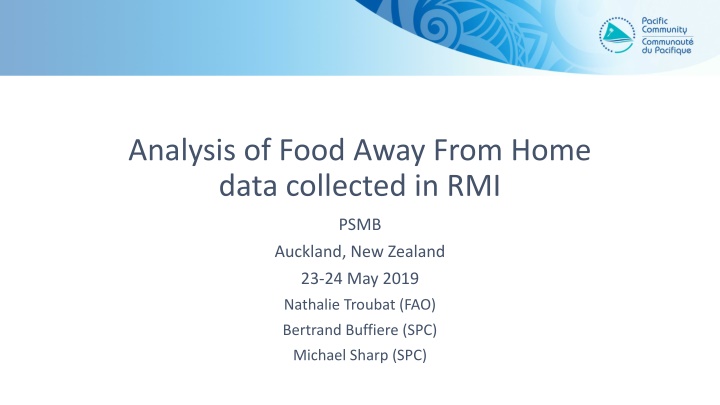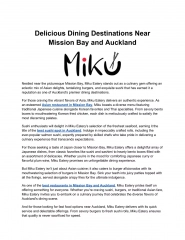Analysis of Food Away From Home Data Collection in Auckland, NZ
Urbanization and economic growth lead to increased consumption of food away from home, impacting calorie intake and food expenditures. Traditional household food consumption surveys may underestimate this trend. Consuming food outside the home often involves calorie-dense, less nutrient-dense options. Capturing accurate data on food away from home is crucial for understanding dietary patterns and their implications on health and expenditure. Recommendations include individual-level data collection with clear definitions, distinguishing between home-prepared and outside-prepared foods, and incorporating meal events and local context into surveys.
Download Presentation

Please find below an Image/Link to download the presentation.
The content on the website is provided AS IS for your information and personal use only. It may not be sold, licensed, or shared on other websites without obtaining consent from the author.If you encounter any issues during the download, it is possible that the publisher has removed the file from their server.
You are allowed to download the files provided on this website for personal or commercial use, subject to the condition that they are used lawfully. All files are the property of their respective owners.
The content on the website is provided AS IS for your information and personal use only. It may not be sold, licensed, or shared on other websites without obtaining consent from the author.
E N D
Presentation Transcript
Analysis of Food Away From Home data collected in RMI PSMB Auckland, New Zealand 23-24 May 2019 Nathalie Troubat (FAO) Bertrand Buffiere (SPC) Michael Sharp (SPC)
Why should we collect FAFH? Rapid urbanization and economic growth are typically associated with an increase in the consumption of food away from home (FAFH) in absolute terms as well as a share of calories and food expenditures. Implementing traditional HCES questionnaires focused on household food consumption at home has the risk of underestimating FAFH by missing the increasing effect on the proportion of calories and expenditure through food systems changes. FAFH consumption is particularly important since food consumed outside the home tends to be more calorie-dense and less nutrient-dense than food consumed at home. The increase in the amount of food consumed away tends to be faster with increases in income.
Does it really matter? Yes it does matter as impact on the average DEC is quite significant . But not homogenous throughout the 5 arms . How FAFH is captured really matters
Recommendations to better capture FAFH Data collection on food away from home should preferably be done at the individual level A separate module should be designed based on a clear definition of food away from home and distinguish between food prepared at home and consumed outside and food prepared outside and consumed at home. Data collection should be organized around meal events, including snacks and drinks. At a minimum, surveys should collect information on the value of all meals consumed during a meal event away from home (breakfast, lunch, dinner, solid snacks or drinks). The meal events list should be adapted to the local context. Surveys should use the same reference period for food away from home as what is used in the food consumed at home module. The data to estimate food away from home-related nutrient content, when feasible, should come from other data sources integrated to the HCES, such as a survey of food establishments or administrative data on the content of public meals, such as those given by schools and social programmes.
Module tested in RMI A separate module was developed to collect FAFH, one for diary and one for recall Reference period was 7 days as for recall and 14 days as for diary Each respondent was asked to report on number of meals consumed outside the house and amount spent if the meal was purchased or amount he/she would spend if the meal was received for free Main meals were: Breakfast Lunch Snack Diner Hot drink Non alcoholic drink Bottled of water (in recall only)
Does the design affect number of meals reported? Recall seems to over estimate the number of meals reported on average. Main type of meals over reported in ARM 1 are non alcoholic beverages, snacks and hot drinks mainly because . ARM1 ARM2 ARM3 ARM4 ARM5 Average number of meals per day 1.18 0.74 0.68 0.57 0.79
. daily quantities of some products are reported more than once in recall by same consumer Quantities per day per consumer of hot drinks, non alcoholic beverages and snacks are reported more than once by same consumer throughout the day while reported only once in diary Item description mean(ave_qu~y) min(ave_qu~y) max(ave_qu~y) hot drinks away from home 1 1 1 non alcoholic drinks away from home 1 1 1 snacks away from home 1 1 1
If ARM1 tends to report higher number of meals consumed away from home, this is also the ARM that shows more disparity in distribution 10 8 number_meal_pd 6 4 2 0 ARM 1 ARM 2 ARM 3 ARM 4 ARM 5
Does the lower number of records in diary can be attributed to a fatigue effect in reporting on FAFH ? Apart from ARM 3 we do not observe a special fatigue of the respondents in filling the section on FAFH in the diary in second week compared to first week
If recall report higher number of meals consumed away from home, diaries tend to perform better in capturing on average more consumers consuming away from home
Design also affects the average amount spent on FAFH per day per household If compare to ARM 2 our baseline, PAPI low supervision diary tends to under estimate* the average amount spent by households. Unbounded recall tends to better capture FAFH compare to bounded recall * After deletion of three extreme values observed in ARM 4
Does it matter to split by type of meal? Yes, because the cost of a meal is different from one meal to the other*, diner consumed away from home being more expensive than a bottle of water consumed away from home * Average over all arms
Zooming at the average cost of one meal per ARM. how the FAFH section was how the FAFH section was administered matters as administered matters as for instance in ARM1 the for instance in ARM1 the design matters as in ARM design matters as in ARM 1 breakfasts and dinner 1 breakfasts and dinner are reported as being are reported as being more more costly costly compared to compared to the other ARMs the other ARMs
Contribution of energy from meals consumed away from home to total energy consumed Lunch seems to be the meals contributing the most to FAFH Recall seem to under report the overall share of FAFH in total energy consumed Well supervised diary performs equally well either when data is collected through PAPI or CAPI Bounded recall does not seem to perform better compared to not bounded recall ARM 1 ARM 2 ARM 3 ARM 4 ARM 5 Average contribution of FAFH to total energy consumed 9.3% 13.7% 12.7% 11.5% 6.4%
Conclusion This basic analysis confirmed that Current survey design was under estimating impact of FAFH on overall dietary energy consumed A well supervised diary seem to better capture the amount of energy consumed away from home but CAPI performs better Bounded recall seem to under estimate the average amount of energy consumed away from home compared to unbounded recall recall Important to split by meals consumed as this may help respondent to remember the food consumed away from home and allow to better capture FAFH























